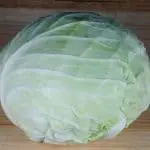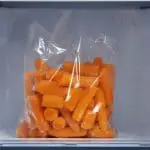In short, yes, you can freeze coleslaw, but it’s important to consider the type of dressing used and be aware that the texture and flavor may be affected after thawing
Crunchy, creamy, and nutritious, coleslaw is a popular salad addition to lunches, dinners, and barbecues. With a standard base of shredded cabbage and carrots, it is so easy to prepare and can be made in a few different ways to suit your preference.
The only downfall about this delicious slaw is that it doesn’t last terribly long. Luckily, it is possible to preserve your favorite salad by freezing it. However, there are a few things you will have to take into consideration before determining whether your batch of coleslaw is freezer- friendly or not.
Here is everything you need to know about freezing coleslaw.
Can Coleslaw Be Frozen?
Yes, as mentioned above, it can be frozen depending on the type of dressing you have used for your coleslaw salad. Below is what you need to know before heading to the freezer with your slaw.
Raw Slaw Base
The raw base of shredded cabbage and carrots without any other additions or dressing can be frozen to preserve and used later. Due to the high water content of cabbage, it may not be suitable for coleslaw to be thawed, but it is ideal to be added to a cooked dish.
Mayonnaise Coleslaw
The coleslaw that has already been mixed with mayonnaise cannot be frozen for reuse. Freezing mayonnaise denatures the texture causing it to separate. Not only is it unappetizing, but it can also be a food safety hazard.
Vinegar-based Coleslaw
Vinegar-based coleslaw can be frozen safely as the vinegar, sugar, and spices in the dressing help to preserve the shredded vegetables. Note that it should be frozen while it is still fresh.
The texture of the coleslaw mix may not remain crunchy after freezing as the drastic temperature changes may alter the crisp quality.
How To Freeze Ready-Made Vinegar Coleslaw
If you have made a vinegar-based coleslaw and need to freeze the leftovers, don’t wait for too long to do so. The coleslaw that is a couple of days old poses the risk of bacterial growth, which could cause food poisoning.
If the coleslaw is not good to eat before freezing, it will definitely not be good to eat after freezing. Here is what you need to do to successfully preserve your coleslaw in the freezer:
Step 1: Food Safety
Ensure that the coleslaw you intend to freeze is fresh and has not been left out of the refrigerator for too long. Your coleslaw should be well coated in an apple cider vinegar or other vinegar-based dressing.
It is best to avoid the addition of ingredients such as shredded lettuce, onions or apples if intending to freeze coleslaw. These ingredients have very high water content and will go soggy upon defrosting.
Step 2: Portion
Divide your slaw into the portion sizes you wish to freeze so that you do not have to thaw an entire large batch if you only need one or two servings.
Step 3: Bag and Seal
Place each portion into a separate zip lock freezer bag. Lie the bag flat and lightly press out all the air before sealing tightly. Any extra air trapped in the bag can cause oxidation and freezer burn, which can spoil your salad.
Step 4: Freeze
Place the sealed bags in the freezer.
How To Freeze Shredded Cabbage For Coleslaw
If you wish to freeze cabbage with the intention of using it in a homemade coleslaw recipe, you will have to prepare it properly to ensure it remains well-preserved.
There are two methods you can use to prepare raw cabbage for freezing.
Method 1: Salt-water Soak Shredded Cabbage
Step 1: Cut and Rinse
Remove wilting leaves from the head of cabbage, cut it in half, and give it a good rinse in cold water. Once you have removed the core, slice the cabbage into thin shreds, ideal for your slaw mix.
Step 2: Salt-water Soak
Cabbage discolors quickly after it has been cut due to oxidation. Soaking it in a salt-water solution will extend the appearance and the texture of your slaw.
Add 1 to 2 tablespoons of salt to a bowl of water deep enough to cover your shredded cabbage. Submerge the shredded cabbage for at least 15 minutes. You can alternatively soak it in a vinegar-water solution.
Step 3: Dry
After 15 minutes, remove the cabbage from the water, shaking off the excess water, and placing it on a clean dishcloth or paper towel. Allow it to air dry for a few minutes.
Step 4: Portion and Pack
Once dry, you can portion the cabbage shreds in the quantities in which you will need to defrost them. Place each serving into a freezer bag that can be sealed tightly. Lie the bag flat and lightly squeeze out all the air before sealing the packet.
It is important to remove all the air from the bag as this can cause freezer burn and ruin your frozen veggies.
Step 5: Freeze
Place the sealed freezer bags in the freezer.
Note: As you can probably figure it out, you can also freeze bagged dry coleslaw mix by placing it in a freezer bag and squeeze out any excess air then seal the bag before labelling and dating it.
Method 2: Blanching Shredded Cabbage
Step 1: Cut and Rinse
Remove wilting leaves from the head of cabbage, cut it in half, and give it a good rinse in cold water. Once you have removed the core, slice the cabbage into thin shreds, ideal for your slaw mix.
Step 2: Blanch
Prepare a pot of boiling water as well as an ice bath in a large bowl. Submerge the cabbage shreds in the boiling water for a maximum of 2 minutes and then immediately plunge them into the ice water to stop the cooking process.
Step 3: Dry
Remove the cabbage from the ice bath and shake off the excess water. Lay the shreds on a clean dishcloth or paper towel. Allow it to air dry for a few minutes or blot it lightly to dry.
Step 4: Portion and Pack
Once dry, you can portion the cabbage shreds in the quantities in which you will need to defrost it. Place each serving into a freezer bag that can be sealed tightly. Lie the bag flat and lightly squeeze out all the air before sealing it.
Step 5: Freeze
Place the sealed freezer bags in the freezer.
Check our guide how to freeze cabbage for more specific tips.
How To Thaw Coleslaw
Coleslaw must be kept at a constant cool temperature in order to remain fresh and safe to eat.
Step 1: Refrigerate
Place the bag of frozen coleslaw in the refrigerator to defrost overnight. Coleslaw should never be thawed at room temperature or in a bowl of water as this could lead to harmful bacterial growth.
Step 2: Drain and Dress
Once completely defrosted, drain any excess moisture from the thawed coleslaw and stir in the mayonnaise dressing as desired. Alternatively, add the cabbage mix to a cooked meal.
Common Types of Coleslaw
Coleslaw is typically a mix of shredded cabbage and carrots tossed in a dressing. Some recipes include the addition of chopped onions, apples, herbs, and raisins.
Creamy Coleslaw
Creamy coleslaw is made with a dressing of mayonnaise or a creamy mayonnaise substitute. This slaw is not suitable for freezing after the dressing has been mixed into the salad and need to be kept in the refrigerator.
Vinegar Coleslaw
Vinegar coleslaw dressing is made with vinegar, salt, and sometimes a small amount of oil. This type of coleslaw is suitable for freezing.
FAQs
Conclusion
Planning ahead can save you a great deal of food wastage, but for those unpredictable times when you just seem to have too much coleslaw leftover, it’s great to know that you can freeze coleslaw and preserve your extras for later use.
If the coleslaw mix has lost its crisp texture after freezing, there are still a multitude of other cooked dishes you can use it in. The golden rule when it comes to freezing coleslaw—only add mayonnaise to your slaw after defrosting. Never freeze a slaw that contains mayonnaise or is slightly old.
Creamy, crunchy, or slightly tangy, enjoy your versatile veggie mix.
Up Next: How To Freeze Chicken Salad
Image by depositphotos/Nikolay_Donetsk









